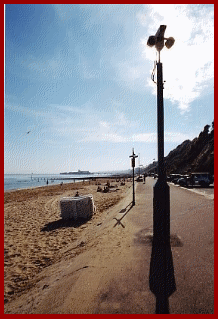| ||||||||||||||||||||||||||||||
Welcome to the | ||||||||||||||||||||||||||||||
 | ||||||||||||||||||||||||||||||
 | ||||||||||||||||||||||||||||||
CCTV cameras on the move | ||||||||||||||||||||||||||||||
The first proper consideration is whether the unit is intended to be used indoors, or for an external application. If it is outdoor, the next key factor is whether the camera is being used in conjunction with Infra Red illuminators, for ‘Black Light’ night operation. For example, if Two IR lamps are to be fitted onto the P/T head, then an Over the Top design will allow these illuminators to be bolted directly onto the pan and tilts side plates, below the pivot point, and thus provide a very effective counterbalance to the weight of the camera assembly (see photo above); nice and neat and easy to install. If a single lamp is to be used, it could be fitted with a special adaptor bracket, above the housing or SM pan and tilt head. Placing the lamp below the housing is a definite no no. Why is that? Having decided on the option for Side Mount or Over the Top, the next decision is based on weight capacity. If you calculate the overall load in kilogrammes (include the camera + lens + housing + wiper + telemetry or control card if fitted into the housing), think about how prone the intended location will be to high winds, and then add a factor of 50 - 100% extra for good measure. With all this information, you then consider whether variable speed and preset positioning are important, in which case you have to look at a low voltage DC head. If not, there is the option of using any of the AC units, though from personal experience, Doktor Jon would generally recommend the 24v AC head, purely on the grounds of safety. One final but vital consideration is the choice of bracketry to support the assembly. In some locations, an appropriate pole or tower may be used; or if it is being bolted to a building, a suitable heavy duty bracket assembly, secured by Rawlbolts, or an equivalent heavy duty anchor should be employed; always make sure that the fixing material is sound, and avoid any bolt or fixing holes within 150 - 200 mm from the edge of a wall (with a heavy wind loading, the wall can crack and the camera drop off! It’s also highly advisable to fix a seperate (steel cable) safety lanyard, just in case the brickwork decides it’s not as strong as it thought it was. | ||||||||||||||||||||||||||||||
 | ||||||||||||||||||||||||||||||
IMPORTANT: No material may be reproduced, copied or redistributed from this site, © doktorjon.co.uk 2004 - 2008 Homepage...:...Gateway...:...Technical Gateway....:....Quickfind Index....:....Equipment Directory | ||||||||||||||||||||||||||||||

